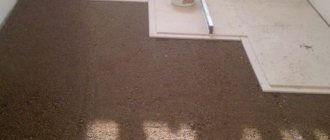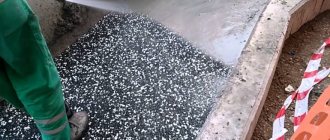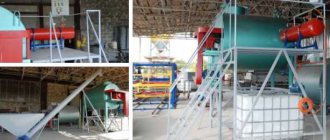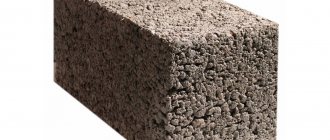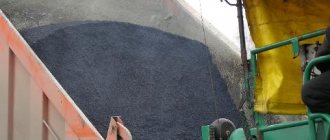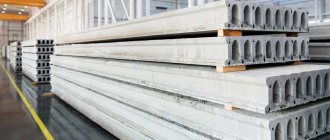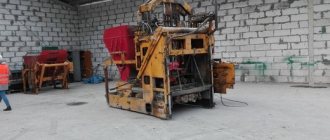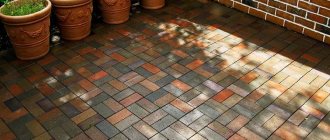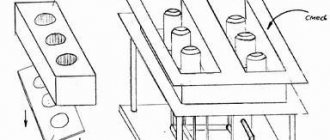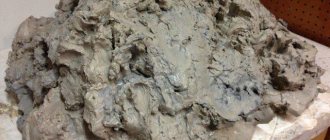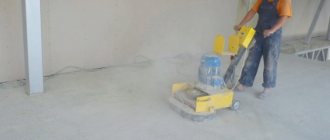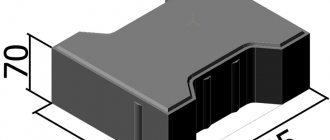Polymer concrete (also called cast or artificial stone, polymer cement, concrete polymer and plastic concrete) is an alternative type of concrete mixture in which a polymer (synthetic resin) is used instead of the standard binder. Thanks to this component and cheaper mineral fillers, the composition is highly resistant to moisture and frost, but at the same time the price of cast stone is lower. Let's take a closer look: polymer concrete - what is it and is this material really worth using in construction as a replacement for conventional concrete?
To answer this question, we first determine what components plastic concrete includes.
Composition of polymer concrete
The lion's share of the polymer cement composition is occupied by filler and it is added in two types at once:
- Ground – talc, graphite powder, andesite flour, ground basalt, mica and other raw materials.
- Coarse – gravel, crushed stone, quartz sand.
Important! When producing cast stone, metal dust, cement lime and chalk should not be used.
Resin is used as a “fastening” component:
- furano-epoxy (must meet the requirements of TU 59-02-039.13-78);
- furfural acetone (FAM), meeting the standards of TU 6-05-1618-73;
- urea-formaldehyde (corresponds to GOST 14231-78 standards);
Polyester resin is often used to hold the filler together, as it is cheaper than others. It is also allowed to use methyl methacrylate monomer (methyl ester) that meets the standards of GOST 16505.
In addition, the cast stone contains hardeners, plasticizing additives and coloring components. They must also meet the requirements for chemical additives (GOST 24211).
Depending on the quantity and type of components, polymer concrete of different qualities can be obtained.
What do foreigners say?
In fact, not only Russian manufacturers make products from polymer concrete. A semi-automatic line for the production of facing materials based on cast stone operates in France. In Japan, polymer concrete wells for cable ducts are produced; other Japanese manufacturers produce reliable polymer concrete pipes reinforced with fiberglass. The Germans also did not stand aside, having mastered the production of wall blocks, panels and other products based on fine-grained concrete polymer.
The activities of American companies that have also mastered the production of polymer concrete products deserve special attention in this direction. In particular, they produce pipes d=300-3000 mm and wall thickness 10 mm. They are used in pressure mains, including treatment facilities working with hazardous media. They have established the production of durable finishing boards and wall panels, where natural products are used as filler - rice husks, sawdust and others. In one of the US laboratories, heat-resistant polymer concrete pipes have been developed for use in geothermal installations.
Types of polymer concrete
Depending on what kind of filler (or rather its fraction) you added to the cast stone solution, you can obtain material both for creating light decorative elements and for constructing more massive structures.
Based on this, the following classes of polymer concrete are distinguished:
- Super heavy. The density of such concrete ranges from 2.5 to 4 t/m3. Components of at least 2-4 cm in size are used as fillers for super-heavy building materials. This type of concrete is used for the construction of structures that are subject to great pressure (load-bearing structures, foundations).
- Heavy (density from 1.8 to 2.5 t/m3). This type of plastic concrete is suitable for the production of decorative cast stones that imitate marble and other expensive stones. The size of the heavy polymer concrete aggregate should not exceed 2 cm.
- Easy. Since the density of such material is 0.5-1.8 t/m3, it is usually classified as structural-thermal insulation class concrete. This type of concrete polymer is distinguished by high heat conservation rates. The filler used for its preparation is the same fraction as for heavy polymer concrete, only its quantity changes.
- Ultralight. The density of this composition is from 0.3 to 0.5 t/m3, so it is used for thermal insulation work and in the construction of internal partitions. The fillers most often used are various shavings, perlites, cork and polystyrene with a fraction of no more than 1 cm.
Healthy! Most often, polymer concrete is used for the manufacture of: kitchen countertops, sinks, window sills, columns, steps, monuments, fireplaces, fountains, floors, vases and much more.
There is also the lightest artificial stone, with a filler no larger than 0.15 mm. This material has found application in the production of decorative elements.
Comparison of polymer concrete and concrete
A comparison of the technical characteristics of concrete and polymer concrete showed that in some respects the latter is many times ahead of its famous rival. First of all, the research concerned the strength of both materials, and it turned out that cast stone is about five times stronger, which cannot go unnoticed, since the durability of such a material is much higher. In addition, polymer concrete:
- has the best performance in resisting compression and bending;
- wears less, therefore it is recommended for cladding steps of stairs and other surfaces subject to frequent mechanical stress (the wear resistance of the material is 10-15 times higher than that of concrete);
- high frost resistance: polymer concrete can withstand up to 500 freeze-thaw cycles, and in this indicator it is close to fiber-reinforced concrete made using innovative C3 technology;
- chemical passivity, and cast stone has high resistance to nitric, sulfuric acid, ammonia and other chemicals;
- ideal decorative properties, which designers use.
Polymer concrete is a large group of materials, the composition and characteristics of which differ. This composition is calculated depending on the scope of application of polymer concrete products. It is worth noting that the scope of their application is very wide.
Properties of polymer concrete
If we compare polymer concrete with ordinary concrete, it is worth noting the fact that in many of its characteristics the composition with the addition of resins outperforms conventional mixtures. Polymer concrete has the following properties:
- density – 300-3000 kg/m3;
- resistance to compression – from 50 to 110 MPa;
- bending resistance – from 3 to 11 MPa;
- abrasion in the range of 0.02-0.03 g/cm2;
- temperature limit – from 60 to 140 0С;
- elasticity – from 10,000 to 40,000 MPa;
- thermal conductivity coefficient – 0.05-0.85 W/m K;
- moisture absorption volume – 0.05-0.5%;
The strength characteristics of polymer concrete are 3-6 times higher than those of conventional concrete. The same applies to tensile strength, which is almost 10 times higher for concrete polymer.
It is also worth taking into account the chemical passivity of modern concrete composition, which is determined according to GOST 25246-82. From this regulatory document it follows that at 200 0C Celsius, the chemical resistance of concrete polymer components to nitric acid will be no less than 0.5%, and to hydrochloric acid, ammonia or calcium solution no less than 0.8%.
Based on this, we can conclude that polymer concrete, which contains resins, has all the qualities necessary for the construction of various objects.
Areas of application of polymer concrete
Polymer concrete is used today in a variety of fields - both for basic construction tasks and structures, and for the production of certain items. The material is used to make countertops for kitchens, bathrooms, sinks, fireplaces, window sills, balusters, railings, sinks, steps, columns, vases, floors, monuments, fences, stucco on the facade, fountains, etc.
Kitchen countertops
Polymer concrete countertops look very stylish, expensive, and can be of any color and texture. At the same time, such products are quite inexpensive (in comparison with natural stone, which they can imitate, for example), practical, wear-resistant, and durable.
There is a huge selection of options on the market, among which choosing one that suits the decor of the room will not be difficult. The countertops are comfortable to use: pleasant to the touch, easy to clean, and do not require special care.
Visually, such a countertop is practically no different from natural stone, but in terms of characteristics and resistance to aggressive influences it is significantly superior.
Floors
Polymer concrete floors are created easily and quickly - they are poured in the same way as ordinary concrete ones, quickly and simply. But such floors are already ready for use, as they are smooth, even, do not generate dust, and are easy to clean. The coating is not afraid of high loads, it is plastic, its minimum warranty period is 10 years, provided the coating is 2 millimeters thick. The thicker the layer, the stronger and more durable it will be.
Polymer concrete floors look very beautiful and stylish; they can be of different colors and textures. They are often made not only in residential premises, but also in industrial workshops, warehouses, hangars, garages, and airports.
Facade decor
Compared to natural stone, the advantages of polymer concrete in creating facade structures are significant. Externally, the material imitates any texture - be it granite or marble, but at the same time its weight is significantly less, which makes the cladding simple and quick, without the need to form a serious foundation and auxiliary fortifications.
Polymer concrete can easily withstand frost and precipitation, is easy to install, has a wide color palette and original texture, durability and reasonable cost. The material is used to make columns, bas-reliefs, pilasters, cornices and other facade decorative elements. The finished products are obtained with clear shapes, strong and reliable, and are easily attached to the surface of the facade.
Monuments
Monuments made from polymer concrete are as strong and durable as marble or granite. Polymer concrete is good because it better withstands negative influences - precipitation, frost, snow, without becoming covered with cracks and other damage. The shiny and smooth surface makes the product aesthetically pleasing and ensures maximum clarity of the design.
Advantages and disadvantages of casting stone
Polymer cement is often used in the construction of structures that cannot be made from ordinary concrete due to its fragility. Thanks to the polymer composition, structures will be less susceptible to deformation or destruction.
In addition, polymer concrete has the following advantages:
- Due to the high water resistance and resistance of the concrete polymer to temperature changes, drops of water on the surface of the finished product evaporate almost immediately, as a result of which cracks and other defects do not form.
- The surface of the polymer cement remains smooth throughout its entire service life, so polymer concrete products do not get dirty.
- The variety of colors allows you to create from this material products stylized to resemble expensive natural rocks (granite, marble, etc.).
- The material is recyclable with the possibility of reusing concrete polymer.
- Structures made from this lightweight concrete do not require additional processing.
If we talk about the disadvantages of modern material, it is worth highlighting the following disadvantages:
- Flammability of polymer concrete.
- The high cost of some binding components (however, if you use ground flour as a filler, the costs will be significantly reduced).
- It is not always possible to find on sale everything necessary for the production of such a composition.
Speaking about the production of polymer concrete, it is worth considering possible options for producing such concrete.
What is polymer concrete used for?
The importance of this material can hardly be overestimated when it comes to preparing a concrete base for applying a polymer coating or repairing the surface of concrete floors. What positive characteristics does “polymer concrete” have? First of all, it is necessary to note the high strength and wear resistance of polymer concrete, short polymerization period (strength gain), workability during the “life period” of the material and the possibility of application in both thick and thin layers. Polymer concrete has found its greatest use in preparing a concrete base for the installation of polymer floor coverings. It is polymer concrete that is used to fill potholes, cracks, seams, chips and other defects in the concrete base of the floor that were exposed after it was treated with grinding or shot blasting machines. Being a homogeneous material, polymer concrete provides high adhesion force with the polymer coating installed on it.
Methods for producing cast stone
The process of producing concrete polymer can be continuous or batch.
Continuous production
In this case, we are talking about large-scale production, for which you will need to purchase the appropriate equipment:
- Vibrating table
- Stirrer.
- Compressor system with gun.
- Silicone matrices.
- Hood.
- Grinding and polishing machines.
To purchase everything you need you will have to spend about 250,000 rubles. Even if you take into account that you will make some of the equipment yourself, the most expensive tools will have to be purchased. Therefore, we will not dwell on this production method and will consider a more accessible technology.
How to make polymer concrete with your own hands
Making polymer concrete with your own hands is much cheaper than buying finished products. Recently, the technology for creating high-quality polymer concrete with your own hands has become available to the public, while maintaining all the positive properties of the material. Polymer concrete, what is it? Polymer concrete is a solid base or slab made from a mixture of crushed stone and resins, for which special chemical compounds are used for adhesion. Slabs for floors and kitchen surfaces are made from polymer concrete; the material is used in masonry walls, as well as for creating memorial stands or monuments.
Composition for the production of polymer concrete
The composition of polymer concrete includes crushed stone or gravel, sand, ground filler, binders, and concrete. The choice of gravel or crushed stone as a solid filler depends on what kind of texture is needed. The crushed stone has a uniform color, the stones are approximately the same size. Gravel, on the other hand, has a completely different structure; the stones have a variety of colors, shades and are smaller in size compared to crushed stone.
Sand for the production of polymer concrete is used clean, sifted, it is advisable to use quartz sand.
Unsaturated polyester resin, urea-formaldehyde, furan-epoxy, furfural acetone resin or methyl methacrylic acid ester are used as a binding agent. The type of binding agent does not affect the appearance of the slab, but for bonding materials it is best to use affordable resins in proportion to mineral flour made from microparticles. In order to improve the thermal insulation properties of the slab, saponified wood resin is added to the solution. To improve the quality of the manufactured slabs, for their high strength, surfactants are used, such as an antiseptic, dye, saponified resin, etc. These substances form pores in polymer concrete, which ensures a good thermal insulation effect inside the building.
Mold for polymer concrete
How to make polymer concrete with your own hands?
- It is necessary to prepare all the materials for this: a solid base, sand, resins, mineral flour and tools. Forms for polymer concrete, concrete mixer, trowel, knife and other items as needed.
- Solid materials must be thoroughly washed and dried in advance, not allowing the moisture content of the materials to exceed 1-2%; this reduces the quality of the polymer concrete being produced.
- The sand must be cleaned of foreign particles by sifting through a special construction sieve; if it is wet, it must be dried. Solid materials used must be dry.
- It is necessary to begin the process of mixing materials in increasing order of their density. The heaviest substance in terms of density is cement, so it is loaded first. Sand and gravel or crushed stone are then added. All materials are mixed well in dry form, and then water is added and the composition is mixed.
- The resin must be brought into a soft state; it can be softened with a solvent or heated. The necessary surfactants are added to the soft resin and after that the entire composition is thoroughly mixed.
- The binder combines with the resin and mixes with solid materials. The composition is thoroughly mixed until a homogeneous mass is obtained.
Polymer concrete hardens very quickly; after mixing, it is necessary to urgently spread the mass into molds and clean the vessel in which the materials were mixed.
Do-it-yourself polymer concrete is ready, its technical characteristics are so good that blocks and slabs of polymer concrete are used for installing external walls, for interior decoration, as well as in interior decoration and for creating furniture.
Concrete blocks in construction and their functions
Installation of walls made of modern concrete blocks is quite convenient due to the dimensions of the blocks; in addition, modern technologies for creating slabs and blocks significantly improve their quality and service life. If polymer concrete blocks are used more often for interior work, then in exterior construction walls are laid from expanded clay concrete blocks. These are also high-quality blocks that retain heat better than ordinary concrete and are easy to construct and use. A concrete wall made of expanded clay can be insulated both from the inside and outside. If this is a residential premises, it can be insulated at the request of the owner, and if the premises are for utility purposes, interior finishing or plaster without insulation is sufficient. Installation of concrete walls involves the use of cement mortar during laying. If decorative finishes are being installed indoors, glue, silicone or cement mortar are used.
Having a concrete wall surface in the house, you need to know how to properly assemble and install technical elements in the walls: sockets, baseboards, cornices, etc.
Correct installation of building elements
How to hammer a nail into a concrete wall? To do this, you need dowels and a mounting gun. The exact location of the nails is marked on the wall surface and the dowel is driven into the wall using a mounting gun. In order to install large structures to a concrete wall, use dowels of at least 10 mm in diameter, with a recess into the wall surface of at least 100 mm. If lightweight structures are being installed, dowels with a diameter of 8 mm with a recess in the wall of at least 30 mm are used. During the installation of structures, it is recommended to use construction adhesive to lubricate the dowel holes to ensure safe load bearing.
Installing socket boxes in a concrete wall requires special responsibility, because incorrect installation of the socket box leads to it falling out of the wall along with the wiring. Plastic socket boxes are used for concrete walls. Using a hammer drill with a Pobedit drill and teeth, a hole is drilled in the wall along the diameter of the socket box and its surface is cleaned. After this, the socket box must be installed in the wall; the previously de-energized wires should be pulled out through the hole cut inside the socket box. If there is no hole, you can cut it yourself using a construction knife. Using the self-tapping screws that come with the socket box, attach the socket box to the wall. Installation of socket boxes in a concrete wall is ready.
Installing socket boxes in a concrete wall
How to attach a plinth to a concrete wall? To attach the plinth to a concrete wall, you will need: a drill, dowels, and self-tapping screws. In a pre-designated location on the wall, a hole is drilled using a drill through the baseboard. That is, both the wall and the baseboard are drilled at the same time. The drill bit must be selected according to the dowels. The dowels must be inserted into the concrete wall at a distance of approximately 40-60 cm. The plinth is secured to the wall with dowels using a self-tapping screw or nail.
Conclusion on the topic
If all requirements are met, making polymer concrete will not be difficult. The main thing is to follow the instructions and then there will be no problems
postroystenu.ru
How to prepare polymer concrete yourself
The first step is to prepare the starting materials: crushed stone of the required fractions, quartz sand with a grain size of no more than 5 mm, ground filler, for example, mineral flour, binder resin.
The approximate composition by weight in percentage terms is as follows: crushed stone - 51%, quartz sand - 26%, mineral flour - 11%, synthetic polymer resin - 10%, the rest is modified additives.
Making polymer concrete with your own hands involves a number of sequential operations. To do this you need:
- Remove dirt and rinse coarse aggregates.
- Sift the sand and separate out the impurities in it.
- Dry the washed aggregates, ensuring the desired moisture content. It is recommended to use only a dry component with a moisture content not exceeding 0.5% - 1%. Failure to comply with this parameter will significantly reduce the strength of the final product.
- Load the aggregates into the mixer, strictly observing the following order: first add crushed stone, then sand, and lastly filler.
- Mix the loaded components.
- Prepare the binder. Depending on the synthetic material used, it is softened by heating or diluted with a solvent, bringing it to the desired consistency.
- Add modifying substances to the softened polymer and mix.
- Add the binder to the prepared aggregate mixture.
- Mix the binder resin with the aggregate (1 - 2 minutes).
- Add hardener and mix again for 3 minutes.
It must be borne in mind that the prepared mixture sets quickly, so it must be used immediately by pouring it into formwork or prepared forms.
Among the varieties of polymer concrete, the production of which is carried out in factory conditions, options are produced in the form of dry mixtures. As a filler, they require a fraction not exceeding 1 cm; the mixture is diluted with water. This type of material is suitable for sealing cracks, repairing concrete structures, pouring foundations and installing self-leveling floors.
What it is
Definition
Let's find out what polymer concrete is? The key difference between the material we are interested in and ordinary concrete is that synthetic resins are used as a binder instead of Portland cement. Typically thermoset; less often - thermoplastic.
Reference: thermosetting is a polymer in which, when heated, irreversible chemical changes occur, leading to a change in its strength or other properties. Simply put, after heating once, the plastic no longer melts when it reaches the same temperature. Thermoplastic polymers, on the other hand, undergo a phase transition every time they are heated.
Our hero should not be confused with another material - polymer-cement concrete. In our case, polymers are used as the only binder. Polymer-cement concrete is ordinary concrete based on Portland cement, modified with synthetic additives to give it any specific properties (increased elasticity, wear resistance, water resistance, etc.).
Self-leveling floor made of polymer cement concrete.
Key properties
What does replacing cement with polymers give in terms of consumer qualities?
- Increased tensile strength . Cement-based concretes have excellent compressive strength, but bending or tensile loads are absorbed by the reinforcement frame.
- Reduced fragility . The material is much more resistant to shock loads.
- Elasticity . Where the concrete monolith bursts, the polymer concrete is only slightly deformed.
- Waterproof . Portland cement shrinks significantly when dried, which ensures the porous structure of concrete. In contrast, polymers after the final gain of strength decrease in volume extremely slightly; Moreover, shrinkage does not lead to porosity, but to a slight decrease in the linear dimensions of the finished product.
Let us clarify: in order to improve thermal insulation qualities and reduce weight, in some cases the use of porous aggregates is practiced in the production of polymer concrete products. Expanded clay and perlite sand are used for this purpose. However, the pores of the filler do not come to the surface, and if so, the water resistance does not suffer.
- Frost resistance . Actually, this property directly follows from the previous point: if there are no pores, there is no crystallization of water in them, tearing the material apart when frozen.
The surface of polymer concrete is devoid of open pores.
- Increased wear resistance . The polymer binder is simply stronger than cement stone in tensile strength; It is much more difficult to tear off a particle of filler from it.
- Chemical resistance . And it is due to the properties of polymers: most resins are inert to the action of aggressive gases and liquids.
